Comparative Analysis: Drug and Pesticide Approval in Canada
VerifiedAdded on 2021/12/29
|19
|4798
|22
Report
AI Summary
This report provides a comprehensive overview of the premarket approval processes for pharmaceuticals, pesticides, and industrial chemicals in Canada. It begins by outlining the pharmaceutical approval pathway, including initial research, preclinical studies, clinical trials, the approval process, decision-making, and post-approval considerations. The report then details the premarket approval of pesticides and industrial chemicals, focusing on the role of the Pest Management Regulatory Agency of Canada (PMRAC), and the processes of scientific review, risk management, permission consultation, and application registration. A comparative analysis between the Canadian and U.S. pharmaceutical approval systems highlights key differences, particularly in decision-making and post-approval processes. The report emphasizes the importance of safety, efficacy, and risk assessment in both sectors, offering valuable insights into the regulatory landscape and procedures governing these critical areas of public health and environmental safety.
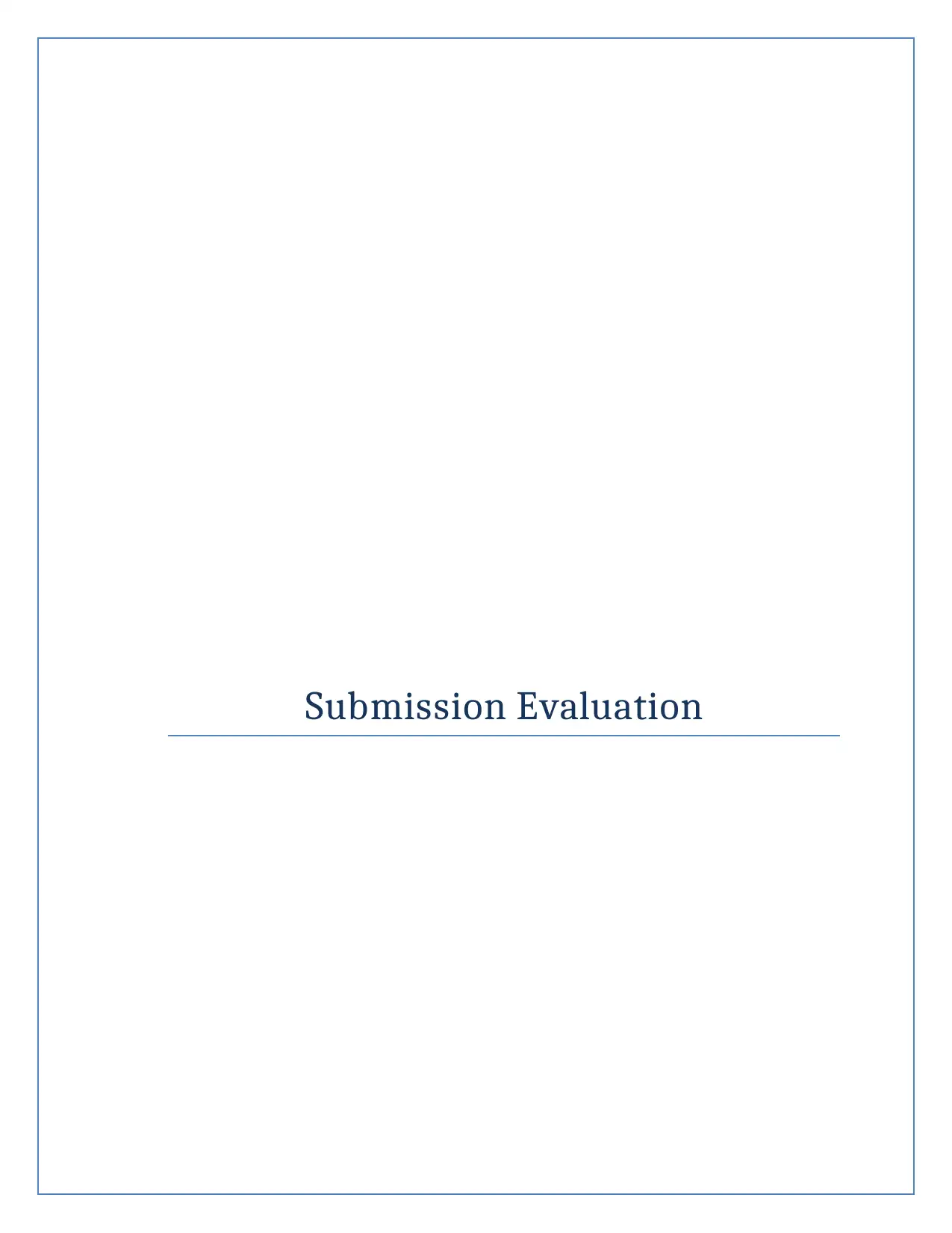
Submission Evaluation
Paraphrase This Document
Need a fresh take? Get an instant paraphrase of this document with our AI Paraphraser
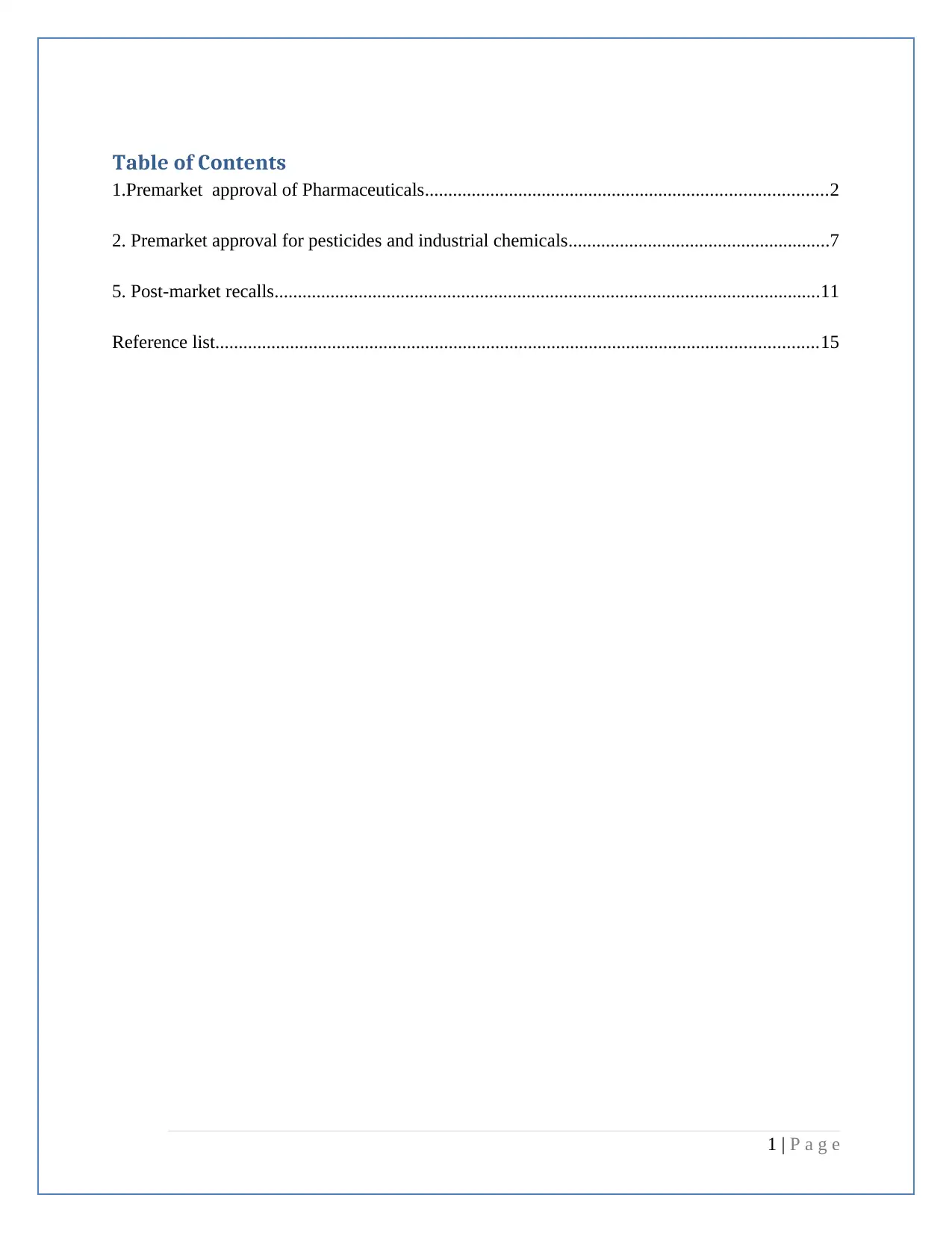
Table of Contents
1.Premarket approval of Pharmaceuticals......................................................................................2
2. Premarket approval for pesticides and industrial chemicals........................................................7
5. Post-market recalls.....................................................................................................................11
Reference list.................................................................................................................................15
1 | P a g e
1.Premarket approval of Pharmaceuticals......................................................................................2
2. Premarket approval for pesticides and industrial chemicals........................................................7
5. Post-market recalls.....................................................................................................................11
Reference list.................................................................................................................................15
1 | P a g e
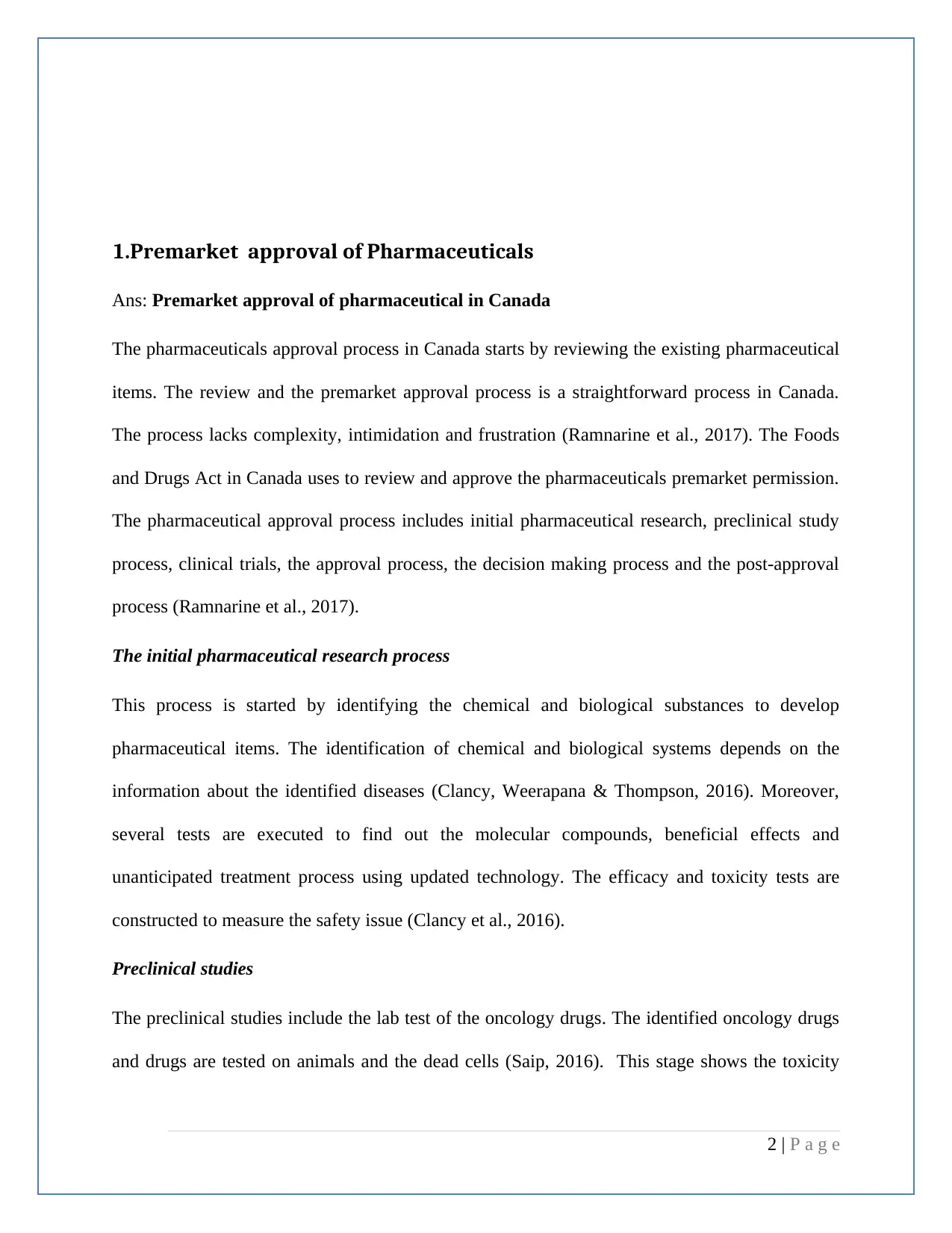
1.Premarket approval of Pharmaceuticals
Ans: Premarket approval of pharmaceutical in Canada
The pharmaceuticals approval process in Canada starts by reviewing the existing pharmaceutical
items. The review and the premarket approval process is a straightforward process in Canada.
The process lacks complexity, intimidation and frustration (Ramnarine et al., 2017). The Foods
and Drugs Act in Canada uses to review and approve the pharmaceuticals premarket permission.
The pharmaceutical approval process includes initial pharmaceutical research, preclinical study
process, clinical trials, the approval process, the decision making process and the post-approval
process (Ramnarine et al., 2017).
The initial pharmaceutical research process
This process is started by identifying the chemical and biological substances to develop
pharmaceutical items. The identification of chemical and biological systems depends on the
information about the identified diseases (Clancy, Weerapana & Thompson, 2016). Moreover,
several tests are executed to find out the molecular compounds, beneficial effects and
unanticipated treatment process using updated technology. The efficacy and toxicity tests are
constructed to measure the safety issue (Clancy et al., 2016).
Preclinical studies
The preclinical studies include the lab test of the oncology drugs. The identified oncology drugs
and drugs are tested on animals and the dead cells (Saip, 2016). This stage shows the toxicity
2 | P a g e
Ans: Premarket approval of pharmaceutical in Canada
The pharmaceuticals approval process in Canada starts by reviewing the existing pharmaceutical
items. The review and the premarket approval process is a straightforward process in Canada.
The process lacks complexity, intimidation and frustration (Ramnarine et al., 2017). The Foods
and Drugs Act in Canada uses to review and approve the pharmaceuticals premarket permission.
The pharmaceutical approval process includes initial pharmaceutical research, preclinical study
process, clinical trials, the approval process, the decision making process and the post-approval
process (Ramnarine et al., 2017).
The initial pharmaceutical research process
This process is started by identifying the chemical and biological substances to develop
pharmaceutical items. The identification of chemical and biological systems depends on the
information about the identified diseases (Clancy, Weerapana & Thompson, 2016). Moreover,
several tests are executed to find out the molecular compounds, beneficial effects and
unanticipated treatment process using updated technology. The efficacy and toxicity tests are
constructed to measure the safety issue (Clancy et al., 2016).
Preclinical studies
The preclinical studies include the lab test of the oncology drugs. The identified oncology drugs
and drugs are tested on animals and the dead cells (Saip, 2016). This stage shows the toxicity
2 | P a g e
⊘ This is a preview!⊘
Do you want full access?
Subscribe today to unlock all pages.

Trusted by 1+ million students worldwide
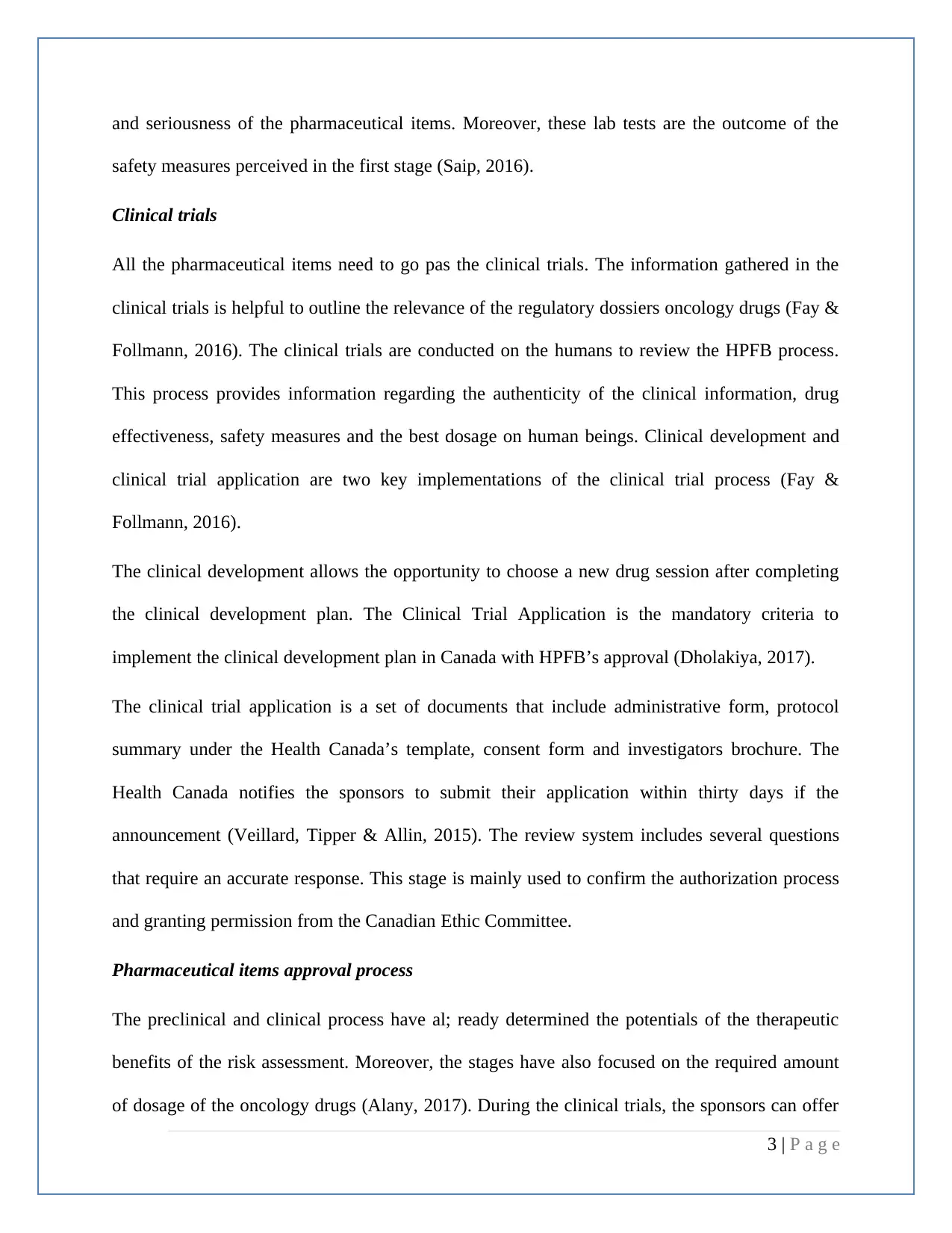
and seriousness of the pharmaceutical items. Moreover, these lab tests are the outcome of the
safety measures perceived in the first stage (Saip, 2016).
Clinical trials
All the pharmaceutical items need to go pas the clinical trials. The information gathered in the
clinical trials is helpful to outline the relevance of the regulatory dossiers oncology drugs (Fay &
Follmann, 2016). The clinical trials are conducted on the humans to review the HPFB process.
This process provides information regarding the authenticity of the clinical information, drug
effectiveness, safety measures and the best dosage on human beings. Clinical development and
clinical trial application are two key implementations of the clinical trial process (Fay &
Follmann, 2016).
The clinical development allows the opportunity to choose a new drug session after completing
the clinical development plan. The Clinical Trial Application is the mandatory criteria to
implement the clinical development plan in Canada with HPFB’s approval (Dholakiya, 2017).
The clinical trial application is a set of documents that include administrative form, protocol
summary under the Health Canada’s template, consent form and investigators brochure. The
Health Canada notifies the sponsors to submit their application within thirty days if the
announcement (Veillard, Tipper & Allin, 2015). The review system includes several questions
that require an accurate response. This stage is mainly used to confirm the authorization process
and granting permission from the Canadian Ethic Committee.
Pharmaceutical items approval process
The preclinical and clinical process have al; ready determined the potentials of the therapeutic
benefits of the risk assessment. Moreover, the stages have also focused on the required amount
of dosage of the oncology drugs (Alany, 2017). During the clinical trials, the sponsors can offer
3 | P a g e
safety measures perceived in the first stage (Saip, 2016).
Clinical trials
All the pharmaceutical items need to go pas the clinical trials. The information gathered in the
clinical trials is helpful to outline the relevance of the regulatory dossiers oncology drugs (Fay &
Follmann, 2016). The clinical trials are conducted on the humans to review the HPFB process.
This process provides information regarding the authenticity of the clinical information, drug
effectiveness, safety measures and the best dosage on human beings. Clinical development and
clinical trial application are two key implementations of the clinical trial process (Fay &
Follmann, 2016).
The clinical development allows the opportunity to choose a new drug session after completing
the clinical development plan. The Clinical Trial Application is the mandatory criteria to
implement the clinical development plan in Canada with HPFB’s approval (Dholakiya, 2017).
The clinical trial application is a set of documents that include administrative form, protocol
summary under the Health Canada’s template, consent form and investigators brochure. The
Health Canada notifies the sponsors to submit their application within thirty days if the
announcement (Veillard, Tipper & Allin, 2015). The review system includes several questions
that require an accurate response. This stage is mainly used to confirm the authorization process
and granting permission from the Canadian Ethic Committee.
Pharmaceutical items approval process
The preclinical and clinical process have al; ready determined the potentials of the therapeutic
benefits of the risk assessment. Moreover, the stages have also focused on the required amount
of dosage of the oncology drugs (Alany, 2017). During the clinical trials, the sponsors can offer
3 | P a g e
Paraphrase This Document
Need a fresh take? Get an instant paraphrase of this document with our AI Paraphraser
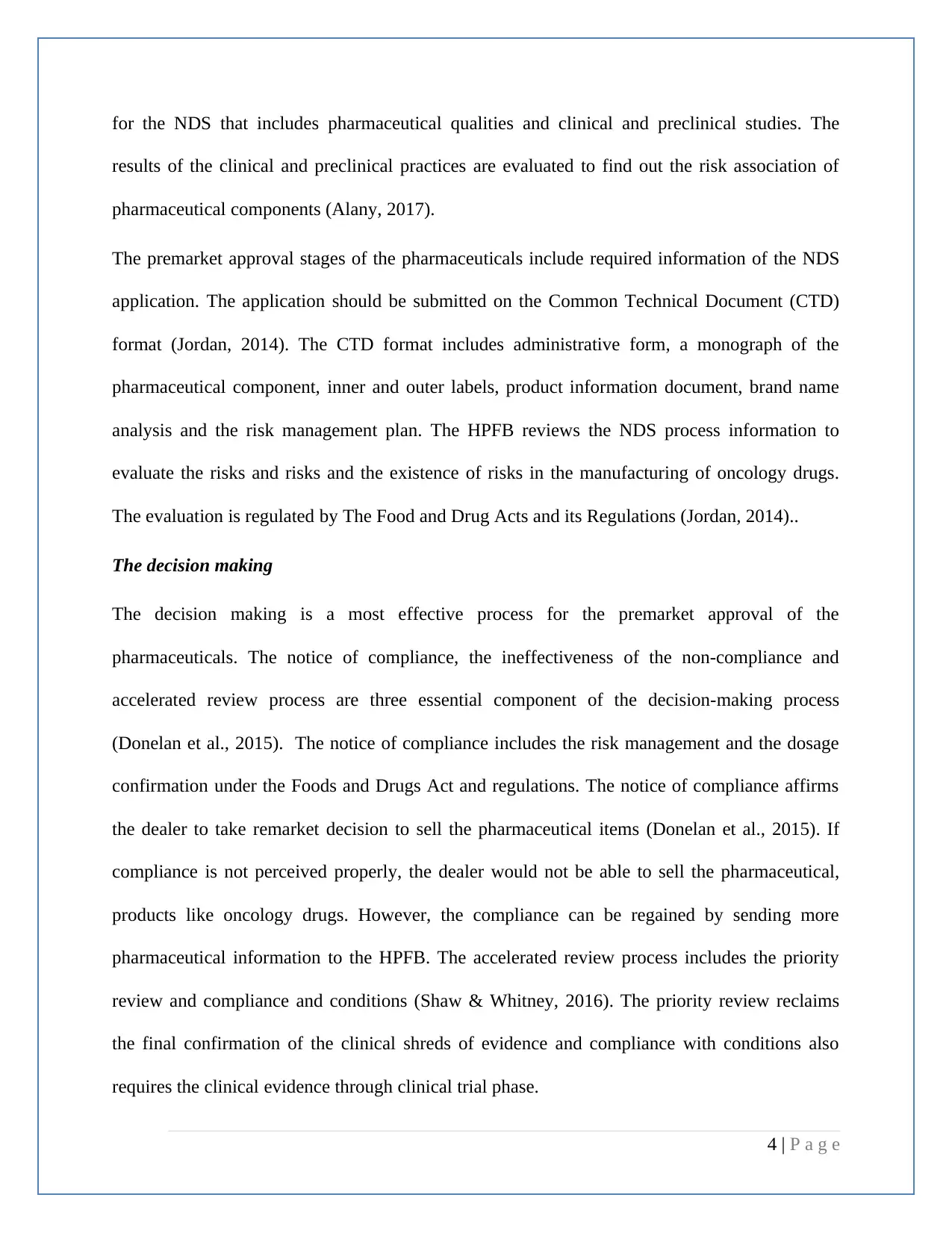
for the NDS that includes pharmaceutical qualities and clinical and preclinical studies. The
results of the clinical and preclinical practices are evaluated to find out the risk association of
pharmaceutical components (Alany, 2017).
The premarket approval stages of the pharmaceuticals include required information of the NDS
application. The application should be submitted on the Common Technical Document (CTD)
format (Jordan, 2014). The CTD format includes administrative form, a monograph of the
pharmaceutical component, inner and outer labels, product information document, brand name
analysis and the risk management plan. The HPFB reviews the NDS process information to
evaluate the risks and risks and the existence of risks in the manufacturing of oncology drugs.
The evaluation is regulated by The Food and Drug Acts and its Regulations (Jordan, 2014)..
The decision making
The decision making is a most effective process for the premarket approval of the
pharmaceuticals. The notice of compliance, the ineffectiveness of the non-compliance and
accelerated review process are three essential component of the decision-making process
(Donelan et al., 2015). The notice of compliance includes the risk management and the dosage
confirmation under the Foods and Drugs Act and regulations. The notice of compliance affirms
the dealer to take remarket decision to sell the pharmaceutical items (Donelan et al., 2015). If
compliance is not perceived properly, the dealer would not be able to sell the pharmaceutical,
products like oncology drugs. However, the compliance can be regained by sending more
pharmaceutical information to the HPFB. The accelerated review process includes the priority
review and compliance and conditions (Shaw & Whitney, 2016). The priority review reclaims
the final confirmation of the clinical shreds of evidence and compliance with conditions also
requires the clinical evidence through clinical trial phase.
4 | P a g e
results of the clinical and preclinical practices are evaluated to find out the risk association of
pharmaceutical components (Alany, 2017).
The premarket approval stages of the pharmaceuticals include required information of the NDS
application. The application should be submitted on the Common Technical Document (CTD)
format (Jordan, 2014). The CTD format includes administrative form, a monograph of the
pharmaceutical component, inner and outer labels, product information document, brand name
analysis and the risk management plan. The HPFB reviews the NDS process information to
evaluate the risks and risks and the existence of risks in the manufacturing of oncology drugs.
The evaluation is regulated by The Food and Drug Acts and its Regulations (Jordan, 2014)..
The decision making
The decision making is a most effective process for the premarket approval of the
pharmaceuticals. The notice of compliance, the ineffectiveness of the non-compliance and
accelerated review process are three essential component of the decision-making process
(Donelan et al., 2015). The notice of compliance includes the risk management and the dosage
confirmation under the Foods and Drugs Act and regulations. The notice of compliance affirms
the dealer to take remarket decision to sell the pharmaceutical items (Donelan et al., 2015). If
compliance is not perceived properly, the dealer would not be able to sell the pharmaceutical,
products like oncology drugs. However, the compliance can be regained by sending more
pharmaceutical information to the HPFB. The accelerated review process includes the priority
review and compliance and conditions (Shaw & Whitney, 2016). The priority review reclaims
the final confirmation of the clinical shreds of evidence and compliance with conditions also
requires the clinical evidence through clinical trial phase.
4 | P a g e
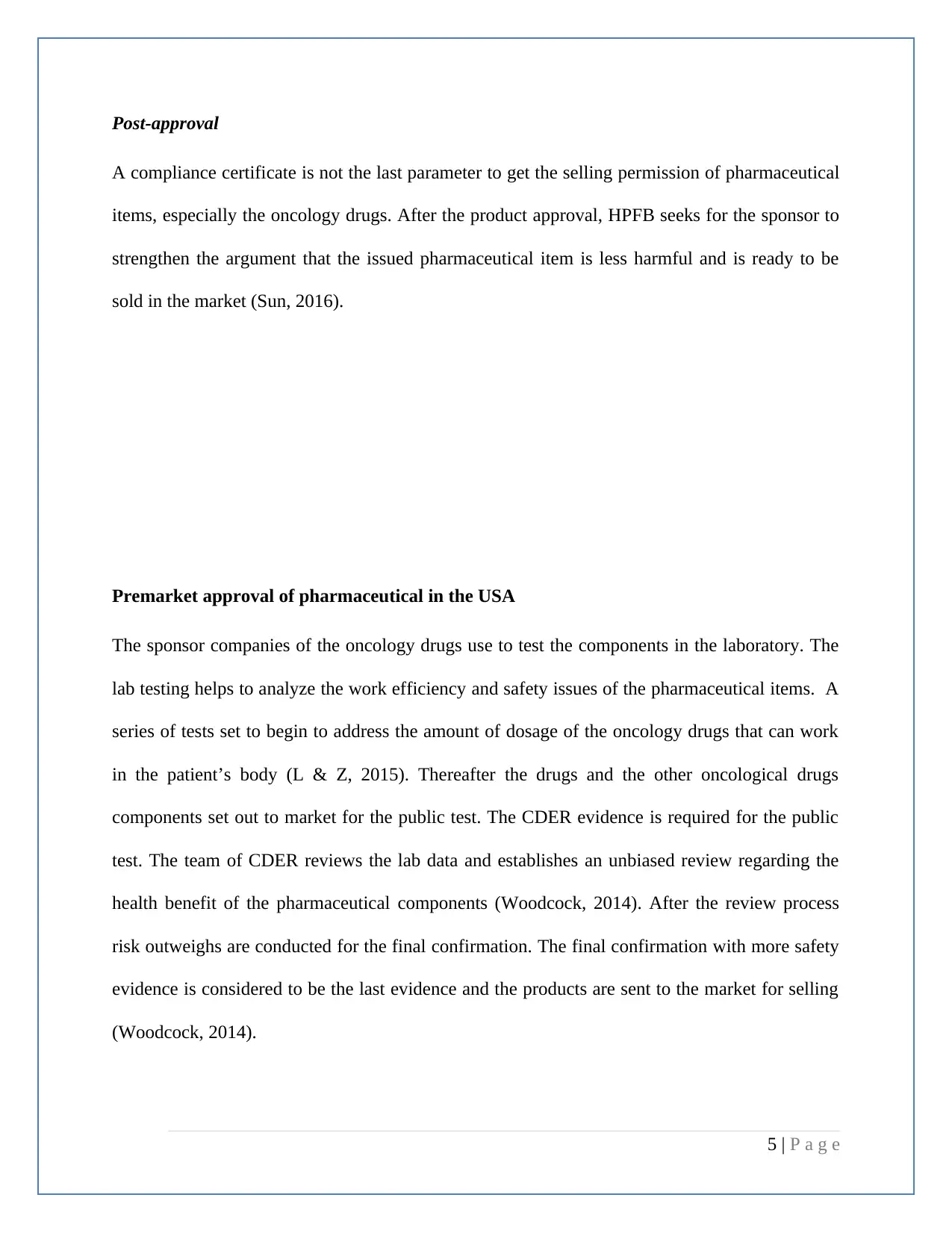
Post-approval
A compliance certificate is not the last parameter to get the selling permission of pharmaceutical
items, especially the oncology drugs. After the product approval, HPFB seeks for the sponsor to
strengthen the argument that the issued pharmaceutical item is less harmful and is ready to be
sold in the market (Sun, 2016).
Premarket approval of pharmaceutical in the USA
The sponsor companies of the oncology drugs use to test the components in the laboratory. The
lab testing helps to analyze the work efficiency and safety issues of the pharmaceutical items. A
series of tests set to begin to address the amount of dosage of the oncology drugs that can work
in the patient’s body (L & Z, 2015). Thereafter the drugs and the other oncological drugs
components set out to market for the public test. The CDER evidence is required for the public
test. The team of CDER reviews the lab data and establishes an unbiased review regarding the
health benefit of the pharmaceutical components (Woodcock, 2014). After the review process
risk outweighs are conducted for the final confirmation. The final confirmation with more safety
evidence is considered to be the last evidence and the products are sent to the market for selling
(Woodcock, 2014).
5 | P a g e
A compliance certificate is not the last parameter to get the selling permission of pharmaceutical
items, especially the oncology drugs. After the product approval, HPFB seeks for the sponsor to
strengthen the argument that the issued pharmaceutical item is less harmful and is ready to be
sold in the market (Sun, 2016).
Premarket approval of pharmaceutical in the USA
The sponsor companies of the oncology drugs use to test the components in the laboratory. The
lab testing helps to analyze the work efficiency and safety issues of the pharmaceutical items. A
series of tests set to begin to address the amount of dosage of the oncology drugs that can work
in the patient’s body (L & Z, 2015). Thereafter the drugs and the other oncological drugs
components set out to market for the public test. The CDER evidence is required for the public
test. The team of CDER reviews the lab data and establishes an unbiased review regarding the
health benefit of the pharmaceutical components (Woodcock, 2014). After the review process
risk outweighs are conducted for the final confirmation. The final confirmation with more safety
evidence is considered to be the last evidence and the products are sent to the market for selling
(Woodcock, 2014).
5 | P a g e
⊘ This is a preview!⊘
Do you want full access?
Subscribe today to unlock all pages.

Trusted by 1+ million students worldwide
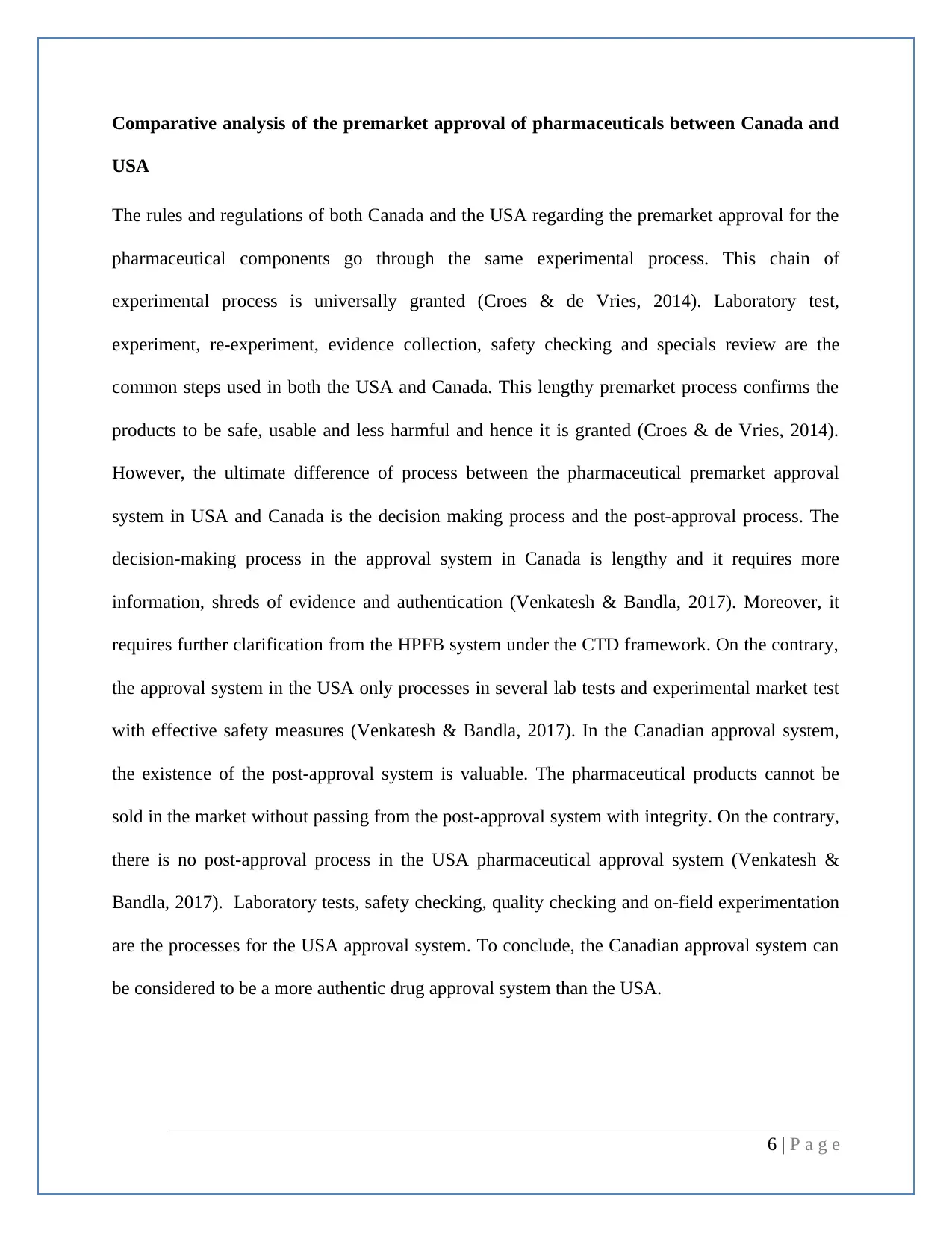
Comparative analysis of the premarket approval of pharmaceuticals between Canada and
USA
The rules and regulations of both Canada and the USA regarding the premarket approval for the
pharmaceutical components go through the same experimental process. This chain of
experimental process is universally granted (Croes & de Vries, 2014). Laboratory test,
experiment, re-experiment, evidence collection, safety checking and specials review are the
common steps used in both the USA and Canada. This lengthy premarket process confirms the
products to be safe, usable and less harmful and hence it is granted (Croes & de Vries, 2014).
However, the ultimate difference of process between the pharmaceutical premarket approval
system in USA and Canada is the decision making process and the post-approval process. The
decision-making process in the approval system in Canada is lengthy and it requires more
information, shreds of evidence and authentication (Venkatesh & Bandla, 2017). Moreover, it
requires further clarification from the HPFB system under the CTD framework. On the contrary,
the approval system in the USA only processes in several lab tests and experimental market test
with effective safety measures (Venkatesh & Bandla, 2017). In the Canadian approval system,
the existence of the post-approval system is valuable. The pharmaceutical products cannot be
sold in the market without passing from the post-approval system with integrity. On the contrary,
there is no post-approval process in the USA pharmaceutical approval system (Venkatesh &
Bandla, 2017). Laboratory tests, safety checking, quality checking and on-field experimentation
are the processes for the USA approval system. To conclude, the Canadian approval system can
be considered to be a more authentic drug approval system than the USA.
6 | P a g e
USA
The rules and regulations of both Canada and the USA regarding the premarket approval for the
pharmaceutical components go through the same experimental process. This chain of
experimental process is universally granted (Croes & de Vries, 2014). Laboratory test,
experiment, re-experiment, evidence collection, safety checking and specials review are the
common steps used in both the USA and Canada. This lengthy premarket process confirms the
products to be safe, usable and less harmful and hence it is granted (Croes & de Vries, 2014).
However, the ultimate difference of process between the pharmaceutical premarket approval
system in USA and Canada is the decision making process and the post-approval process. The
decision-making process in the approval system in Canada is lengthy and it requires more
information, shreds of evidence and authentication (Venkatesh & Bandla, 2017). Moreover, it
requires further clarification from the HPFB system under the CTD framework. On the contrary,
the approval system in the USA only processes in several lab tests and experimental market test
with effective safety measures (Venkatesh & Bandla, 2017). In the Canadian approval system,
the existence of the post-approval system is valuable. The pharmaceutical products cannot be
sold in the market without passing from the post-approval system with integrity. On the contrary,
there is no post-approval process in the USA pharmaceutical approval system (Venkatesh &
Bandla, 2017). Laboratory tests, safety checking, quality checking and on-field experimentation
are the processes for the USA approval system. To conclude, the Canadian approval system can
be considered to be a more authentic drug approval system than the USA.
6 | P a g e
Paraphrase This Document
Need a fresh take? Get an instant paraphrase of this document with our AI Paraphraser
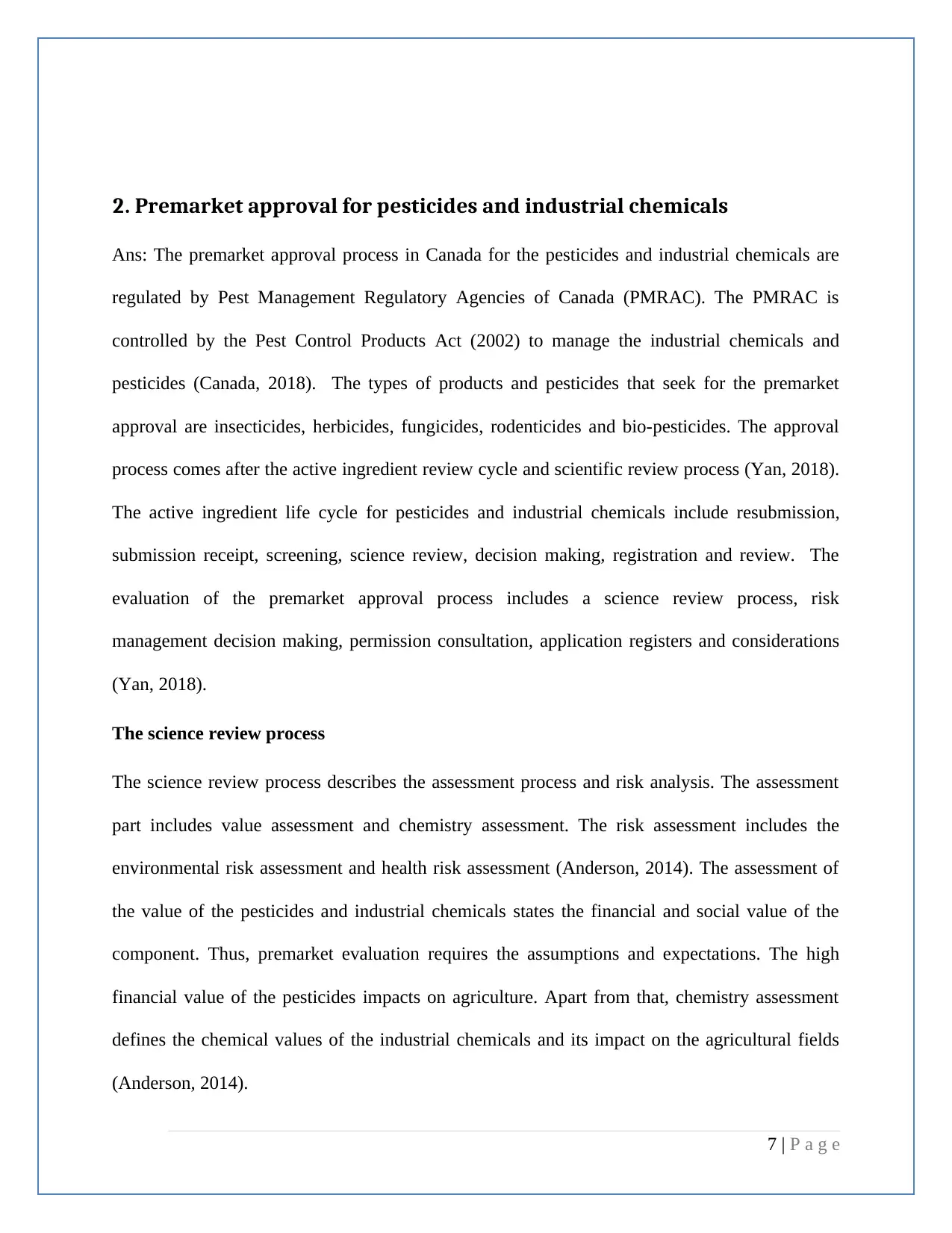
2. Premarket approval for pesticides and industrial chemicals
Ans: The premarket approval process in Canada for the pesticides and industrial chemicals are
regulated by Pest Management Regulatory Agencies of Canada (PMRAC). The PMRAC is
controlled by the Pest Control Products Act (2002) to manage the industrial chemicals and
pesticides (Canada, 2018). The types of products and pesticides that seek for the premarket
approval are insecticides, herbicides, fungicides, rodenticides and bio-pesticides. The approval
process comes after the active ingredient review cycle and scientific review process (Yan, 2018).
The active ingredient life cycle for pesticides and industrial chemicals include resubmission,
submission receipt, screening, science review, decision making, registration and review. The
evaluation of the premarket approval process includes a science review process, risk
management decision making, permission consultation, application registers and considerations
(Yan, 2018).
The science review process
The science review process describes the assessment process and risk analysis. The assessment
part includes value assessment and chemistry assessment. The risk assessment includes the
environmental risk assessment and health risk assessment (Anderson, 2014). The assessment of
the value of the pesticides and industrial chemicals states the financial and social value of the
component. Thus, premarket evaluation requires the assumptions and expectations. The high
financial value of the pesticides impacts on agriculture. Apart from that, chemistry assessment
defines the chemical values of the industrial chemicals and its impact on the agricultural fields
(Anderson, 2014).
7 | P a g e
Ans: The premarket approval process in Canada for the pesticides and industrial chemicals are
regulated by Pest Management Regulatory Agencies of Canada (PMRAC). The PMRAC is
controlled by the Pest Control Products Act (2002) to manage the industrial chemicals and
pesticides (Canada, 2018). The types of products and pesticides that seek for the premarket
approval are insecticides, herbicides, fungicides, rodenticides and bio-pesticides. The approval
process comes after the active ingredient review cycle and scientific review process (Yan, 2018).
The active ingredient life cycle for pesticides and industrial chemicals include resubmission,
submission receipt, screening, science review, decision making, registration and review. The
evaluation of the premarket approval process includes a science review process, risk
management decision making, permission consultation, application registers and considerations
(Yan, 2018).
The science review process
The science review process describes the assessment process and risk analysis. The assessment
part includes value assessment and chemistry assessment. The risk assessment includes the
environmental risk assessment and health risk assessment (Anderson, 2014). The assessment of
the value of the pesticides and industrial chemicals states the financial and social value of the
component. Thus, premarket evaluation requires the assumptions and expectations. The high
financial value of the pesticides impacts on agriculture. Apart from that, chemistry assessment
defines the chemical values of the industrial chemicals and its impact on the agricultural fields
(Anderson, 2014).
7 | P a g e
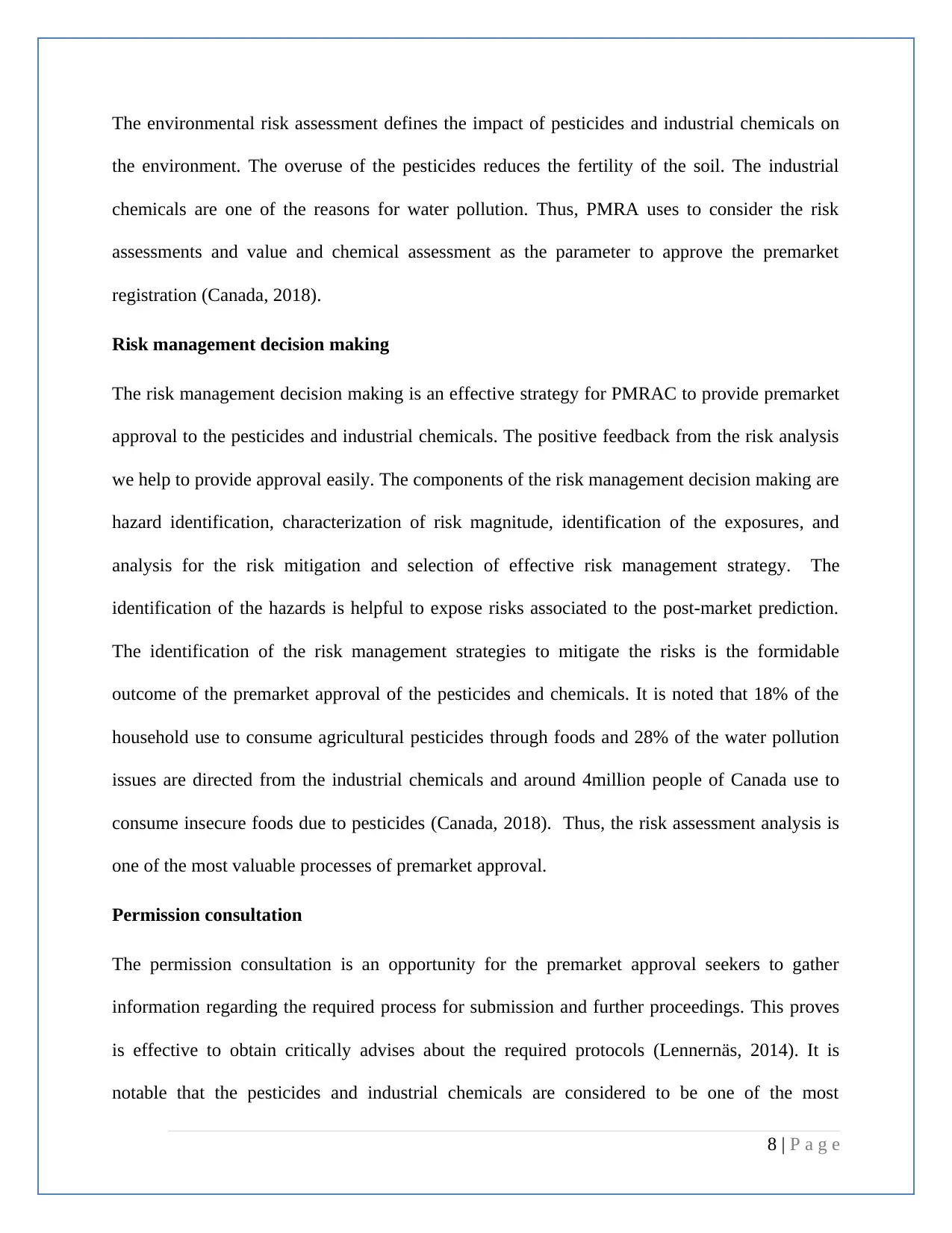
The environmental risk assessment defines the impact of pesticides and industrial chemicals on
the environment. The overuse of the pesticides reduces the fertility of the soil. The industrial
chemicals are one of the reasons for water pollution. Thus, PMRA uses to consider the risk
assessments and value and chemical assessment as the parameter to approve the premarket
registration (Canada, 2018).
Risk management decision making
The risk management decision making is an effective strategy for PMRAC to provide premarket
approval to the pesticides and industrial chemicals. The positive feedback from the risk analysis
we help to provide approval easily. The components of the risk management decision making are
hazard identification, characterization of risk magnitude, identification of the exposures, and
analysis for the risk mitigation and selection of effective risk management strategy. The
identification of the hazards is helpful to expose risks associated to the post-market prediction.
The identification of the risk management strategies to mitigate the risks is the formidable
outcome of the premarket approval of the pesticides and chemicals. It is noted that 18% of the
household use to consume agricultural pesticides through foods and 28% of the water pollution
issues are directed from the industrial chemicals and around 4million people of Canada use to
consume insecure foods due to pesticides (Canada, 2018). Thus, the risk assessment analysis is
one of the most valuable processes of premarket approval.
Permission consultation
The permission consultation is an opportunity for the premarket approval seekers to gather
information regarding the required process for submission and further proceedings. This proves
is effective to obtain critically advises about the required protocols (Lennernäs, 2014). It is
notable that the pesticides and industrial chemicals are considered to be one of the most
8 | P a g e
the environment. The overuse of the pesticides reduces the fertility of the soil. The industrial
chemicals are one of the reasons for water pollution. Thus, PMRA uses to consider the risk
assessments and value and chemical assessment as the parameter to approve the premarket
registration (Canada, 2018).
Risk management decision making
The risk management decision making is an effective strategy for PMRAC to provide premarket
approval to the pesticides and industrial chemicals. The positive feedback from the risk analysis
we help to provide approval easily. The components of the risk management decision making are
hazard identification, characterization of risk magnitude, identification of the exposures, and
analysis for the risk mitigation and selection of effective risk management strategy. The
identification of the hazards is helpful to expose risks associated to the post-market prediction.
The identification of the risk management strategies to mitigate the risks is the formidable
outcome of the premarket approval of the pesticides and chemicals. It is noted that 18% of the
household use to consume agricultural pesticides through foods and 28% of the water pollution
issues are directed from the industrial chemicals and around 4million people of Canada use to
consume insecure foods due to pesticides (Canada, 2018). Thus, the risk assessment analysis is
one of the most valuable processes of premarket approval.
Permission consultation
The permission consultation is an opportunity for the premarket approval seekers to gather
information regarding the required process for submission and further proceedings. This proves
is effective to obtain critically advises about the required protocols (Lennernäs, 2014). It is
notable that the pesticides and industrial chemicals are considered to be one of the most
8 | P a g e
⊘ This is a preview!⊘
Do you want full access?
Subscribe today to unlock all pages.

Trusted by 1+ million students worldwide
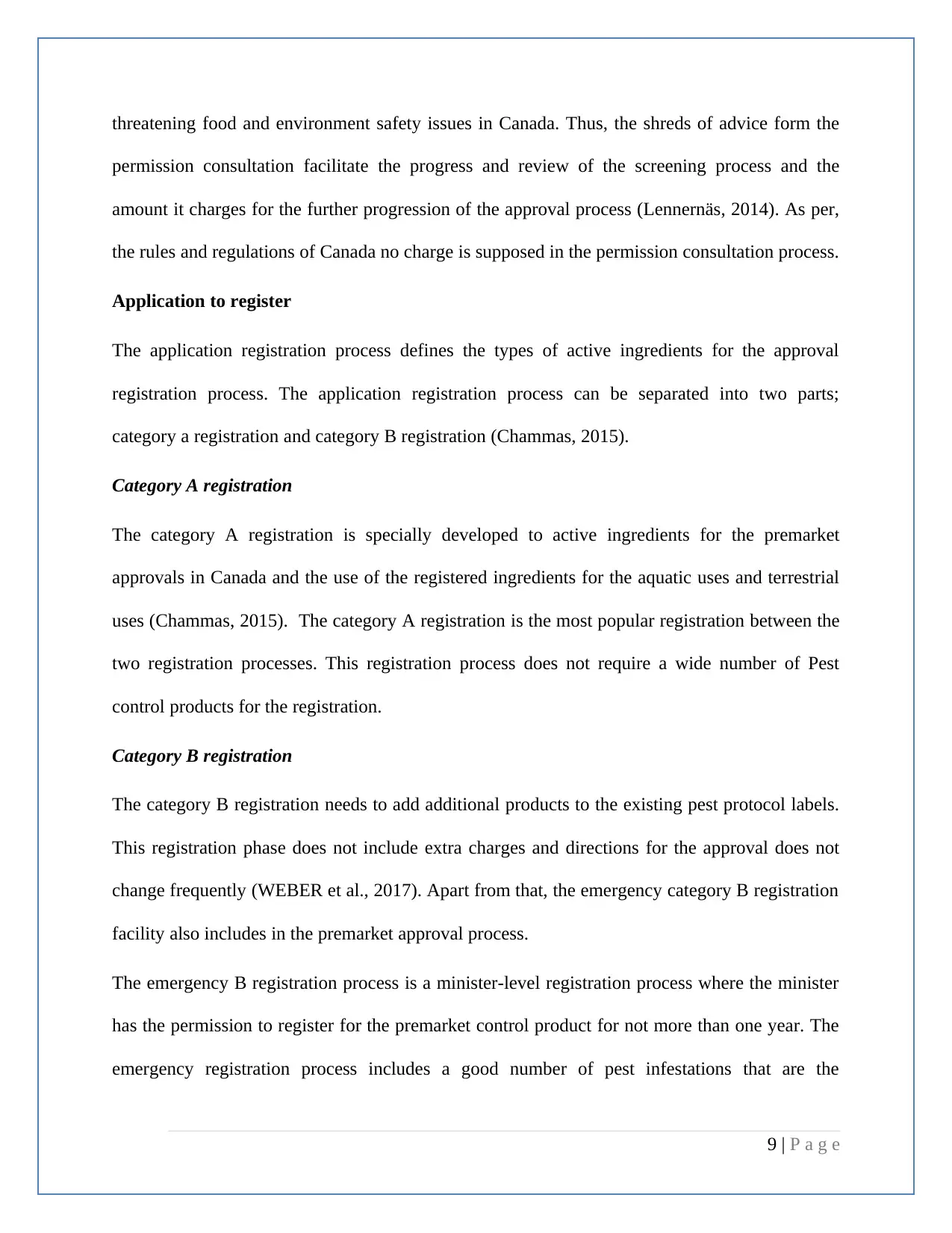
threatening food and environment safety issues in Canada. Thus, the shreds of advice form the
permission consultation facilitate the progress and review of the screening process and the
amount it charges for the further progression of the approval process (Lennernäs, 2014). As per,
the rules and regulations of Canada no charge is supposed in the permission consultation process.
Application to register
The application registration process defines the types of active ingredients for the approval
registration process. The application registration process can be separated into two parts;
category a registration and category B registration (Chammas, 2015).
Category A registration
The category A registration is specially developed to active ingredients for the premarket
approvals in Canada and the use of the registered ingredients for the aquatic uses and terrestrial
uses (Chammas, 2015). The category A registration is the most popular registration between the
two registration processes. This registration process does not require a wide number of Pest
control products for the registration.
Category B registration
The category B registration needs to add additional products to the existing pest protocol labels.
This registration phase does not include extra charges and directions for the approval does not
change frequently (WEBER et al., 2017). Apart from that, the emergency category B registration
facility also includes in the premarket approval process.
The emergency B registration process is a minister-level registration process where the minister
has the permission to register for the premarket control product for not more than one year. The
emergency registration process includes a good number of pest infestations that are the
9 | P a g e
permission consultation facilitate the progress and review of the screening process and the
amount it charges for the further progression of the approval process (Lennernäs, 2014). As per,
the rules and regulations of Canada no charge is supposed in the permission consultation process.
Application to register
The application registration process defines the types of active ingredients for the approval
registration process. The application registration process can be separated into two parts;
category a registration and category B registration (Chammas, 2015).
Category A registration
The category A registration is specially developed to active ingredients for the premarket
approvals in Canada and the use of the registered ingredients for the aquatic uses and terrestrial
uses (Chammas, 2015). The category A registration is the most popular registration between the
two registration processes. This registration process does not require a wide number of Pest
control products for the registration.
Category B registration
The category B registration needs to add additional products to the existing pest protocol labels.
This registration phase does not include extra charges and directions for the approval does not
change frequently (WEBER et al., 2017). Apart from that, the emergency category B registration
facility also includes in the premarket approval process.
The emergency B registration process is a minister-level registration process where the minister
has the permission to register for the premarket control product for not more than one year. The
emergency registration process includes a good number of pest infestations that are the
9 | P a g e
Paraphrase This Document
Need a fresh take? Get an instant paraphrase of this document with our AI Paraphraser
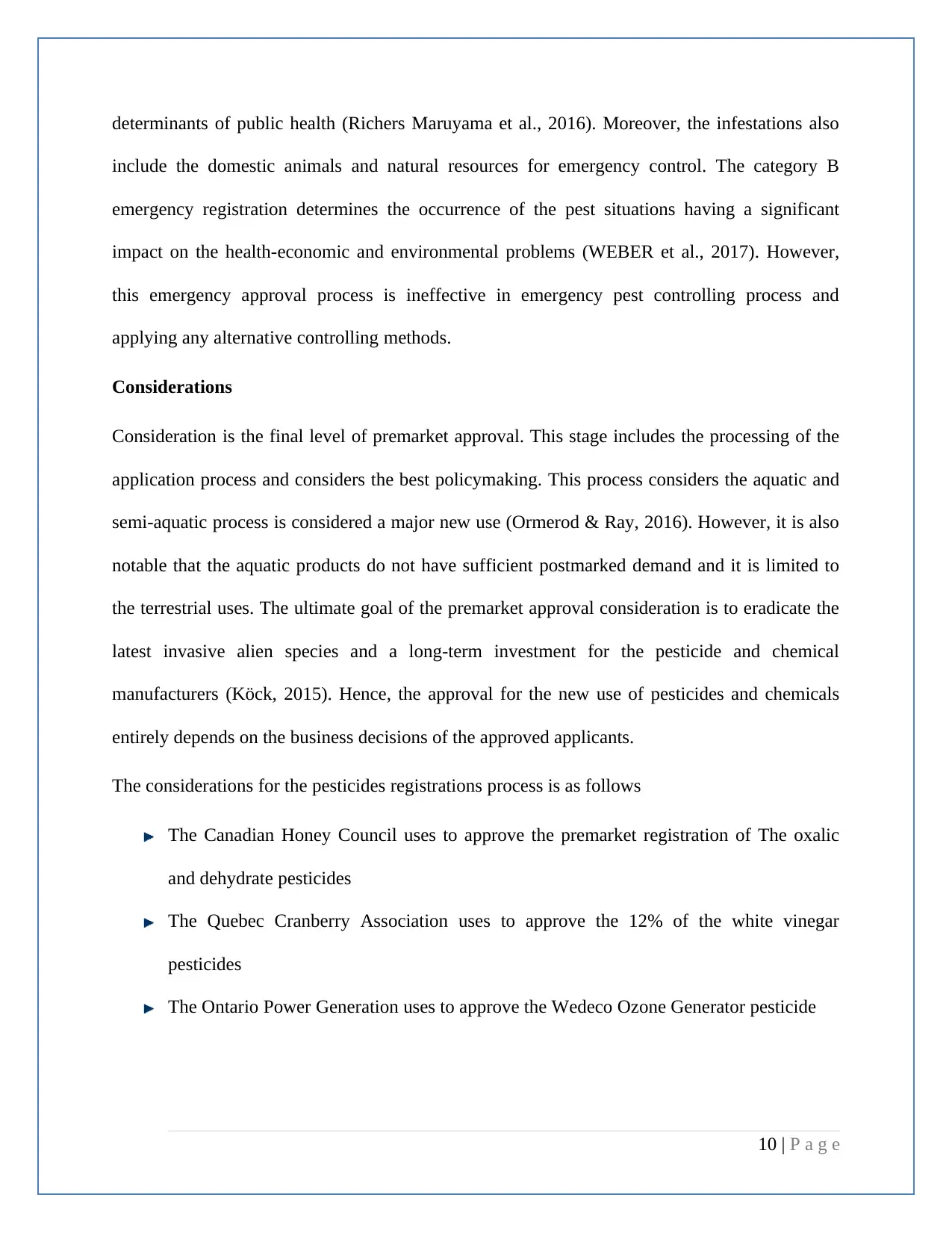
determinants of public health (Richers Maruyama et al., 2016). Moreover, the infestations also
include the domestic animals and natural resources for emergency control. The category B
emergency registration determines the occurrence of the pest situations having a significant
impact on the health-economic and environmental problems (WEBER et al., 2017). However,
this emergency approval process is ineffective in emergency pest controlling process and
applying any alternative controlling methods.
Considerations
Consideration is the final level of premarket approval. This stage includes the processing of the
application process and considers the best policymaking. This process considers the aquatic and
semi-aquatic process is considered a major new use (Ormerod & Ray, 2016). However, it is also
notable that the aquatic products do not have sufficient postmarked demand and it is limited to
the terrestrial uses. The ultimate goal of the premarket approval consideration is to eradicate the
latest invasive alien species and a long-term investment for the pesticide and chemical
manufacturers (Köck, 2015). Hence, the approval for the new use of pesticides and chemicals
entirely depends on the business decisions of the approved applicants.
The considerations for the pesticides registrations process is as follows
The Canadian Honey Council uses to approve the premarket registration of The oxalic
and dehydrate pesticides
The Quebec Cranberry Association uses to approve the 12% of the white vinegar
pesticides
The Ontario Power Generation uses to approve the Wedeco Ozone Generator pesticide
10 | P a g e
include the domestic animals and natural resources for emergency control. The category B
emergency registration determines the occurrence of the pest situations having a significant
impact on the health-economic and environmental problems (WEBER et al., 2017). However,
this emergency approval process is ineffective in emergency pest controlling process and
applying any alternative controlling methods.
Considerations
Consideration is the final level of premarket approval. This stage includes the processing of the
application process and considers the best policymaking. This process considers the aquatic and
semi-aquatic process is considered a major new use (Ormerod & Ray, 2016). However, it is also
notable that the aquatic products do not have sufficient postmarked demand and it is limited to
the terrestrial uses. The ultimate goal of the premarket approval consideration is to eradicate the
latest invasive alien species and a long-term investment for the pesticide and chemical
manufacturers (Köck, 2015). Hence, the approval for the new use of pesticides and chemicals
entirely depends on the business decisions of the approved applicants.
The considerations for the pesticides registrations process is as follows
The Canadian Honey Council uses to approve the premarket registration of The oxalic
and dehydrate pesticides
The Quebec Cranberry Association uses to approve the 12% of the white vinegar
pesticides
The Ontario Power Generation uses to approve the Wedeco Ozone Generator pesticide
10 | P a g e
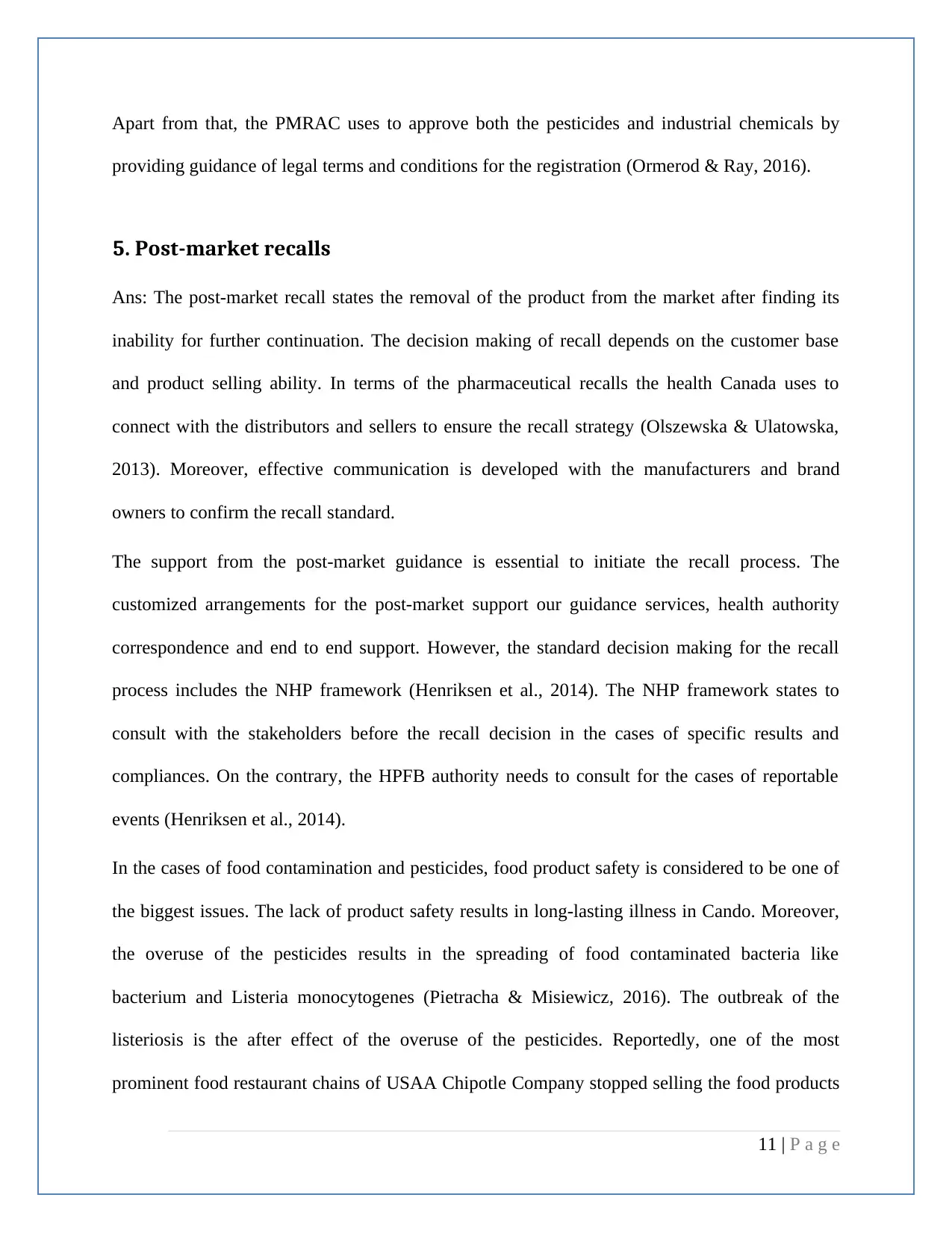
Apart from that, the PMRAC uses to approve both the pesticides and industrial chemicals by
providing guidance of legal terms and conditions for the registration (Ormerod & Ray, 2016).
5. Post-market recalls
Ans: The post-market recall states the removal of the product from the market after finding its
inability for further continuation. The decision making of recall depends on the customer base
and product selling ability. In terms of the pharmaceutical recalls the health Canada uses to
connect with the distributors and sellers to ensure the recall strategy (Olszewska & Ulatowska,
2013). Moreover, effective communication is developed with the manufacturers and brand
owners to confirm the recall standard.
The support from the post-market guidance is essential to initiate the recall process. The
customized arrangements for the post-market support our guidance services, health authority
correspondence and end to end support. However, the standard decision making for the recall
process includes the NHP framework (Henriksen et al., 2014). The NHP framework states to
consult with the stakeholders before the recall decision in the cases of specific results and
compliances. On the contrary, the HPFB authority needs to consult for the cases of reportable
events (Henriksen et al., 2014).
In the cases of food contamination and pesticides, food product safety is considered to be one of
the biggest issues. The lack of product safety results in long-lasting illness in Cando. Moreover,
the overuse of the pesticides results in the spreading of food contaminated bacteria like
bacterium and Listeria monocytogenes (Pietracha & Misiewicz, 2016). The outbreak of the
listeriosis is the after effect of the overuse of the pesticides. Reportedly, one of the most
prominent food restaurant chains of USAA Chipotle Company stopped selling the food products
11 | P a g e
providing guidance of legal terms and conditions for the registration (Ormerod & Ray, 2016).
5. Post-market recalls
Ans: The post-market recall states the removal of the product from the market after finding its
inability for further continuation. The decision making of recall depends on the customer base
and product selling ability. In terms of the pharmaceutical recalls the health Canada uses to
connect with the distributors and sellers to ensure the recall strategy (Olszewska & Ulatowska,
2013). Moreover, effective communication is developed with the manufacturers and brand
owners to confirm the recall standard.
The support from the post-market guidance is essential to initiate the recall process. The
customized arrangements for the post-market support our guidance services, health authority
correspondence and end to end support. However, the standard decision making for the recall
process includes the NHP framework (Henriksen et al., 2014). The NHP framework states to
consult with the stakeholders before the recall decision in the cases of specific results and
compliances. On the contrary, the HPFB authority needs to consult for the cases of reportable
events (Henriksen et al., 2014).
In the cases of food contamination and pesticides, food product safety is considered to be one of
the biggest issues. The lack of product safety results in long-lasting illness in Cando. Moreover,
the overuse of the pesticides results in the spreading of food contaminated bacteria like
bacterium and Listeria monocytogenes (Pietracha & Misiewicz, 2016). The outbreak of the
listeriosis is the after effect of the overuse of the pesticides. Reportedly, one of the most
prominent food restaurant chains of USAA Chipotle Company stopped selling the food products
11 | P a g e
⊘ This is a preview!⊘
Do you want full access?
Subscribe today to unlock all pages.

Trusted by 1+ million students worldwide
1 out of 19
Related Documents
Your All-in-One AI-Powered Toolkit for Academic Success.
+13062052269
info@desklib.com
Available 24*7 on WhatsApp / Email
![[object Object]](/_next/static/media/star-bottom.7253800d.svg)
Unlock your academic potential
Copyright © 2020–2025 A2Z Services. All Rights Reserved. Developed and managed by ZUCOL.



